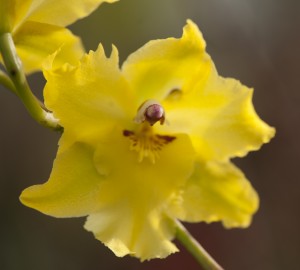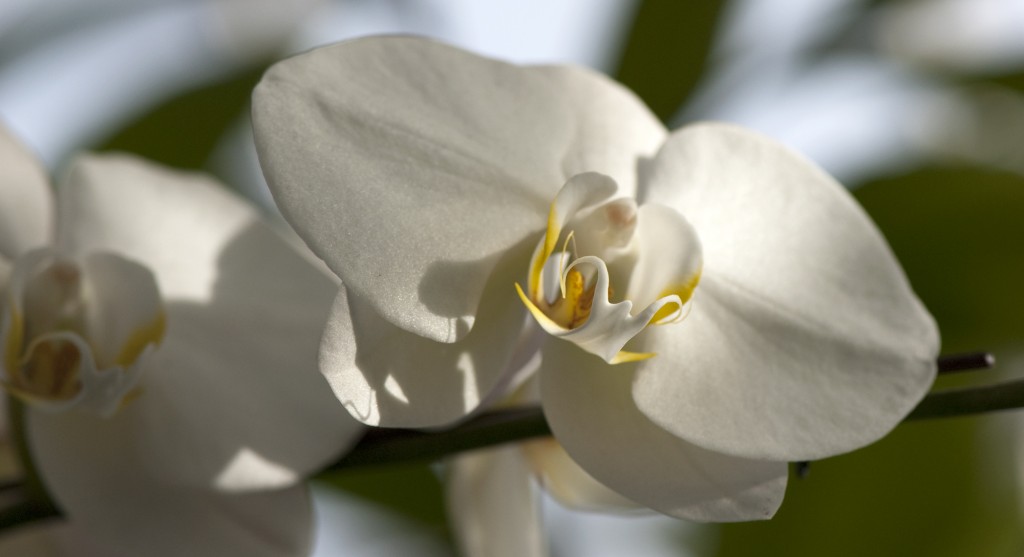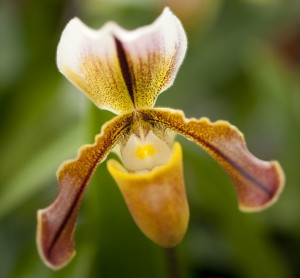Orchid 1-2-3
Posted in Gardening Tips, The Orchid Show on March 27 2012, by Sonia Uyterhoeven
Sonia Uyterhoeven is the NYBG‘s Gardener for Public Education.
 For all of those orchid neophytes or orchid wannabes, this article is about giving you some courage. Not enough bravado to go out and buy a vanda or a masdevallia–that would be foolish to start–but hopefully the resolution to take a stab at a moth orchid, a slipper orchid, or dancing ladies.
For all of those orchid neophytes or orchid wannabes, this article is about giving you some courage. Not enough bravado to go out and buy a vanda or a masdevallia–that would be foolish to start–but hopefully the resolution to take a stab at a moth orchid, a slipper orchid, or dancing ladies.
Let’s start from the beginning, because wise purchases come from planning. Walk around your home and look for the empty spaces that you would like to fill with orchids. What does the light in this area look like? If you are not sure, place your hand 12 inches above the spot and see what kind of shadow is cast on the area. If it is a well-defined shadow, you have bright light; if fuzzy, you have medium light; and a faint shadow signifies low light. If there is no discernible shadow, then it is not the right place to try and grow a plant.
If you have low-level light, you are best off growing slipper orchids (Paphiopedilum) or moth orchids (Phalaenopsis). If you have medium-level light, look to grow moth orchids, complex hybrids (a mix of several different genera), dancing ladies (Oncidium), corsage orchids (Cattleya), pansy orchids (Miltonia), or zygopetalum (Zygopetalum). If you have high levels of light, grow corsage orchids, dendrobium (Denbrobium), lady of the night orchids (Brassavola), or zygopetalums.
It is important to remember that light levels will change throughout the season. A southern window may be an ideal location for a sun-loving orchid in the winter, but it may turn into a scorching desert in the warm summer months. Orchids that demand bright light are often happiest when it is indirect. One solution is to invest in a sheer curtain to provide some protection from hot afternoon sun. An oscillating fan will also keep the air circulating, lowering the temperature and preventing the air from stagnating. You just want to create a gentle breeze similar to what you would encounter in a tropical rain forest.

Aside from light, temperature will also dictate your choice in an orchid. If your home is on the cooler side, consider growing corsage orchids, pansy orchids, zygopetalums and deciduous noble dendrobiums. If you like to keep your home on the warmer side, then an evergreen Den-Phal hybrid (Dendrobium phalaenopsis), a slipper orchid, or moth orchid may be the way to go. Complex hybrids tend to be combinations of cool and warm growing orchids so they are fairly adaptable for average home temperatures.
While it is important to respect an orchid’s temperature needs, remember that most orchids require a temperature differential between day and night temperatures of about 10 to 15 degrees Fahrenheit. If your home is staying too warm at night, sometimes placing the orchid close to a window is enough to provide this temperature fluctuation. Many orchids do best in terms of re-flowering when the fall night time temperatures drop below 65 degrees.

Orchids are classified as either being warm, intermediate, or cool growers. Warm growers such as moth orchids fuss if the nighttime temperature drops below 60F, while intermediate growers such as corsage orchids are happy if nighttime temperatures drop to 55F. Cool growers such as cymbidiums are delighted with temperatures down to 50F. On the other end of the spectrum, most orchids are happy with daytime temperatures rising into the 80s; none of them like temperatures over 90F. Pansy orchids, however, are happier when daytime temperatures are in the 70s.
If your house tends to be on the dry side, either invest in a humidifier or construct a home-made system by filling a shallow tray with pebbles and then filling it with water. Place your orchid pots on top of the tray but remember not to submerge them in water, otherwise the root system will rot. I often take a small pot and turn it upside down, using it as a decorative stand, or I make sure the water level remains below the top layer of pebbles. Clean the tray every few months with a 10% bleach solution (one part bleach to nine parts water).
Now we have three main components for growing orchids successfully under our belt–light, temperature, and humidity. Next week we will explore the purchasing process and look at some tips for successfully introducing your orchid into the home environment.

